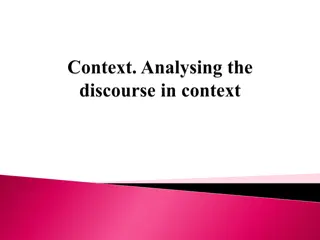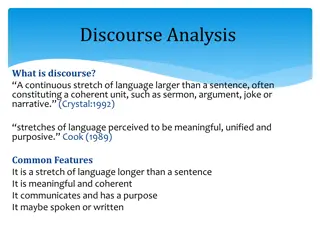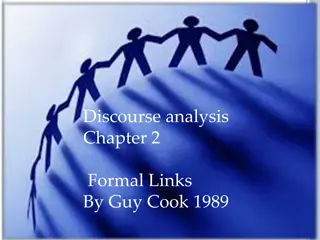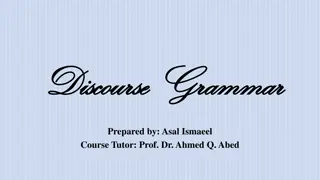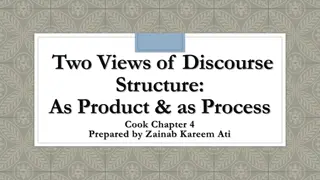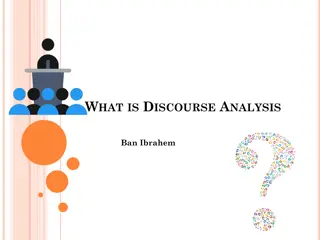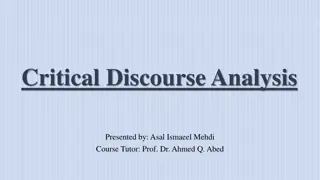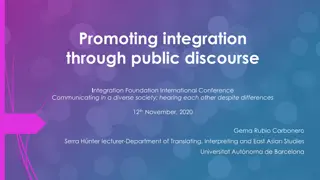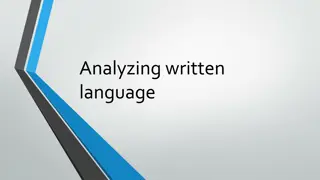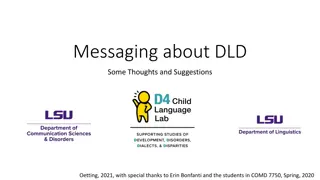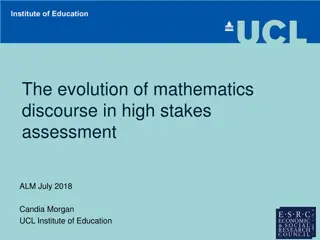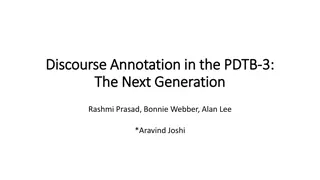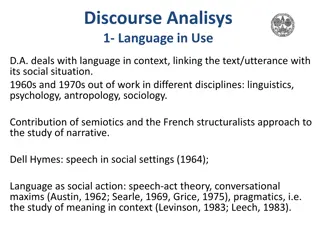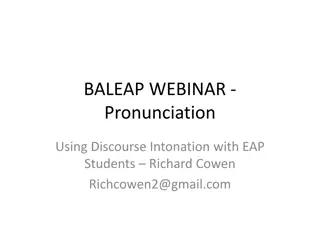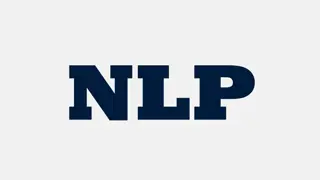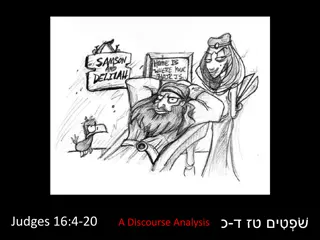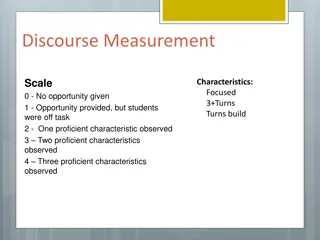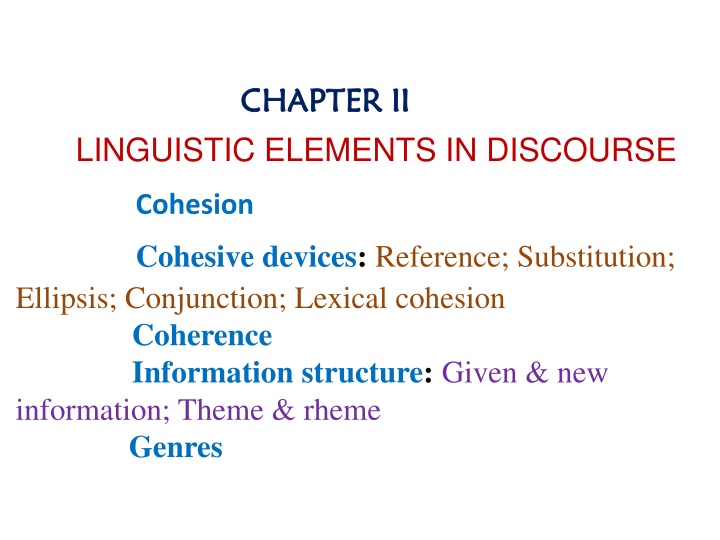
Linguistic Elements in Discourse: Cohesion and Coherence Explained
Learn about the essential linguistic elements in discourse - cohesion and coherence. Explore cohesive devices such as reference, substitution, ellipsis, conjunction, and lexical cohesion to create meaning in text. Understand the concepts of given and new information, theme and rheme, and how they contribute to coherence in different genres of communication.
Download Presentation

Please find below an Image/Link to download the presentation.
The content on the website is provided AS IS for your information and personal use only. It may not be sold, licensed, or shared on other websites without obtaining consent from the author. If you encounter any issues during the download, it is possible that the publisher has removed the file from their server.
You are allowed to download the files provided on this website for personal or commercial use, subject to the condition that they are used lawfully. All files are the property of their respective owners.
The content on the website is provided AS IS for your information and personal use only. It may not be sold, licensed, or shared on other websites without obtaining consent from the author.
E N D
Presentation Transcript
CHAPTER II CHAPTER II LINGUISTIC ELEMENTS IN DISCOURSE Cohesion Cohesive devices: Reference; Substitution; Ellipsis; Conjunction; Lexical cohesion Coherence Information structure: Given & new information; Theme & rheme Genres
COHESION Cohesion is the grammatical & lexical linking (cohesive ties/connections) within a text or sentence that holds a text together & gives it meaning.
2. TYPES OF COHESION - Grammatical cohesion, which is based on structural content - Lexical cohesion, which is based on lexical content & background knowledge. *A cohesive text is created in many different ways. * Five general categories of cohesive devices that create coherence in texts: Reference , Ellipsis (word omission/), Substitution (word/phrase replacement), Lexical cohesion (lexical items) & Conjunction /connectors.
- Lexical Cohesion: Repetition uses the same word, or synonyms, antonyms, etc. For example, "Which dress are you going to wear?" "I will wear my green frock," uses the synonyms "dress" and "frock" for lexical cohesion. Collocation uses related words that typically go together or tend to repeat the same meaning. - Ellipsis: a situation in which words are left out of a sentence but the sentence can still be understood: How many students are there in your group? 25
COHERENCE COHERENCE * Coherence is a Latin word. Its meaning - to stick together. (Every thing fitting together well). * In a composition, coherence is a literary technique that refers to logical connections, which listeners or readers perceive in an oral or written text. > Coherence is a written or spoken piece that is not only consistent & logical, unified & meaningful.
The differences between Cohesion & Coherence Cohesion: In the text; Grammatical links; Clues, Guides to coherence Coherence: In the readers s /listener s mind; The feeling that the text makes sense; The reader has to create coherence.
- In fact: Sometimes A cohesive text (having a lot of connections) is not coherent text (difficult to interpret) Ex. Illustration of the relationship between cohesion & coherence - John forgot to bring the corkscrew. The party was spoilt. (There s no surface link, but it is coherent) - Although Thu is a teacher, she is very honest. (There is a formal cohesive device (conjunction although ), but it is not coherent because the sentence does not sound right according to our common background knowledge)
Grammatical cohesion 1. Substitution: a device showing the relationship between sentences avoiding repetition. They are Pro-form for nouns (pronouns). Pronoun are frequently used where nouns are not repeated. Ex. The guys applied for a scholarship. Unfortunately, they were all rejected. * Pro-forms for adverbials (here, there, then ): My brother lives in the States. He lives there with his wife. * Pro-forms for predicates involving auxiliaries do, can, may, should. Ex. John doesn t smoke. Oh, I think he does. * Pro-forms not &so for direct clause. Ex. Is she leaving tomorrow? I think so/not.
2. Ellipsis:Aform of substitution, the omission of elements which the speaker/writer assumes are obvious from the context. Distinction between substitution & ellipsis: Ellipsis: Simply an omission of certain elements in context, there exists the possibility of recovering them if the speaker or writer wants. Such possibility does not exist to substitution. Ex. * When did he arrive? Probably (she arrived) yesterday. (ellipsis) * The president called on Congress to approve the budget. He thought it was the right thing to do. (substitution do)
3. Structural parallelism Two or more sentences have identical/very similar structure, serving as a means of connecting sentences. The connection is further reinforced by lexical equivalence. Ex. - Wherever there s despair, we bring hope. - Wherever there s fear, we bring confidence.
Logical cohesive devices Sentence connectors demonstrating the logical relationships between sentences. + And: linking 2 clauses in a compound sentence + Enumeration: Indicating a listing of what is being said (first, second next; finally, to begin with, for one thing . +Addition: Additive conjuncts: reinforcing & equative conjuncts: also, too, furthermore, moreover, then, in addition, above all, neither, nor ..
+ Transition: now introduces a new stage in the sequence of thought: with reference to, with regard to, by the way > digression (temporarily changing the topic) + Summation: generalizing, summing up what has been discussed or said earlier: then, all in all, in conclusion, to sum up, in a nutshell + Apposition: used to refer back to the previous sentence: namely (viz), in other words, for example, that is (i.e./ie), for instance
+ Result: Indicating the results or consequences of what was mentioned or said in the preceding sentences: consequently, hence, so, therefore, thus, as a result + Inference: implicit in the preceding sentence: else, otherwise, then, in that case, in other words + Reformulation or replacement: Introducing another way of saying the same thing by means of conjuncts: better, rather, in other words, again
+ Contrast: Introducing by conjuncts: instead, then, on the contrary, in/by contrast, by comparison on the other hand + Concession: (nh ng b ): introducing the unexpected, surprising nature of what being said before: anyhow, anyway, besides however, though, in any case, in spite of that, after all, all the same + Comparison: found in adjectives & adverbs: more, as, less, least
Lexical cohesive devices + Reiteration: lexical equivalent as result of repetition + Synonyms: Lexical equivalent- frequent use in English. + Antonym: a word that has the opposite meaning of another word. + Association: defined as that existing between 2 or more words of one or the same field, possessing some common semantic properties. Ex. Military, conflict, armed forces, unit LEXICAL FIELDS
+ Reference: the symbolic relationship of one linguistic expression to another, in which one provides the information necessary to interpret the other. *Reference includes: # Anaphoric reference (that, those, the former, the later ) which looks backward in the text for its referents # Cataphoric reference (as follows, the following, below ) which looks forward in the text for its referent.
* Although Thu is a teacher, she is very honest (a formal cohesive device although , but it is not coherent because the sentence does not sound right according to our common background knowledge) * H n v a i v a ch i. Ch Ph o x ch m t c i v chai n nh b Ki n. (He cursed as he walked. Chi Pheo went to Ba Kien s house with an empty bottle in his hand.)
SUMMARY * Chapter II mentions about the distinction between cohesion and coherence. * Cohesion is formal links which exist between sentences; Cohesion has 3 types: grammatical, logical & lexical * Coherence is the semantic ties in discourse.
Information structure The information structure refers to the interface between the structure & meaning of linguistic utterances; the interlocutors' mental representations of information, discourse referents, and the overall universe of discourse, on the other. Thu t ng c u tr c th ng tin c p n giao di n gi a c u tr c v ngh a c a l i n i ng n ng ; l c c bi u t tinh th n c a ng i i tho i v th ng tin, tham chi u di n ng n v t ng th v n chung c a di n ng n.
Theme & Rheme *A message consists of two main parts: Theme & Rheme. *Based on Prague School of linguistics: Information structure of a sentence consists of 2 parts: New information & given (old) information The theme - the topic/main character/Topic entity The rheme - the comment Ex. Marry was late again.(Marry: NI) > The Theme is the element which serves as the point of departure of the message. > The remainder of the message, the part in which the theme is developed, is called the Rheme.
In other words, * Theme is left-most constituent of the sentence subject; It is starting point of the utterance. * Rheme is something what the speaker says later.
In short, Theme may be seen as having 2 functions: i) To connect back & link into the previous discourse, maintaining a coherent point of view. ii) Serve as a point of departure for further development of the discourse.
1) The cat ate the rat (the focus is the CAT). 2) The rat was eaten by the cat (the focus is the RAT) * There are 3 types of themes: Topical, Interpersonal & Textual. Ex. Frankly, the movie was a waste of money. However, you should see it & make up your own mind. Interpl. Topical Textual Topical
DISCOURSE STRUCTURE- GENRE * Discourse structure known as genre/style Agenre is a particular type of literature, painting, music, film, or other art form which people consider as a class because it has special characteristics. * Types of discourse structure: Narrative, Descriptive, Procedural, Argumentative
* Narratives: the most universal form of discourse, occuring in all cultures. It s characteristics of organization: beginning with an orientation: the time of the story & spatial setting (character, goal, problem, solution ) Ex. Once upon a time in a small village by the sea, there live an old man & woman .
* Descriptive * Telling a story about something related to the object of description. * The description topics could be: describing a home, a building, a person . * The description based on the syntactic structures: links, relative clauses, prepositional & adverbial phrases
* Procedural/process Called How to discourse because primary purpose is to explain how to accomplish or to do a task. Ex. how to set up a computer set, how to get to airport
* Argumentative * Often describing the process of supporting or weakening another statement whose validity is open to question to doubt. * Classical organization: an introduction, explanation of the case or problem, outline of argument, proof, refutation & conclusion.
Identify the old (given) & new in the example. Good evening & welcome to this is your life . This is Terry Donovan speaking. We re waiting for the subject of tonight s programme. He s one of the world s leading actors, & he thinks he s coming here to take part in a discussion programme I can hear him now yes, here he is! Jason Douglas This is your life!
Revision 1. What are Cohesion & Coherence? Their types. The difference between Cohesion & Coherence. 2. Cohesive devices: Lexical & Grammatical devices. 3.What are Theme & Rheme. Illustrate through examples. 4. What is genre? Its types. 5. Write a short paragraph that demonstrates cohesion & coherence

